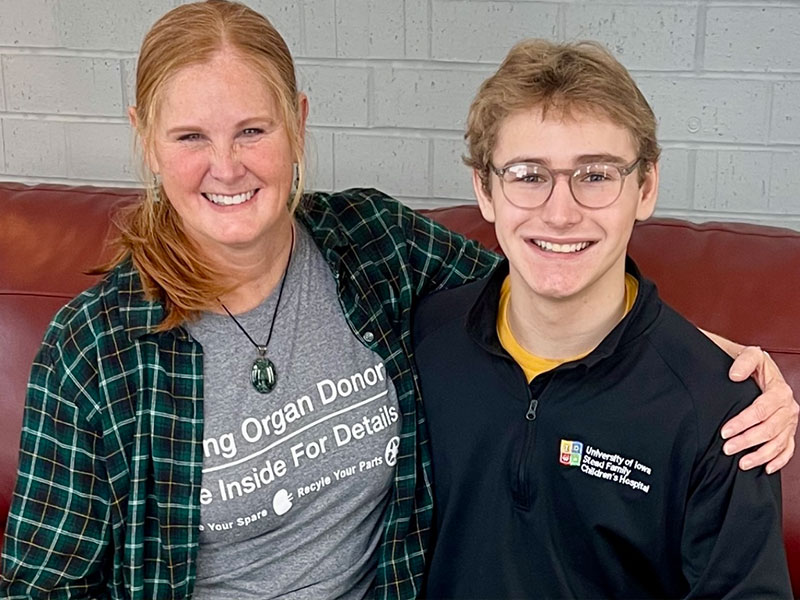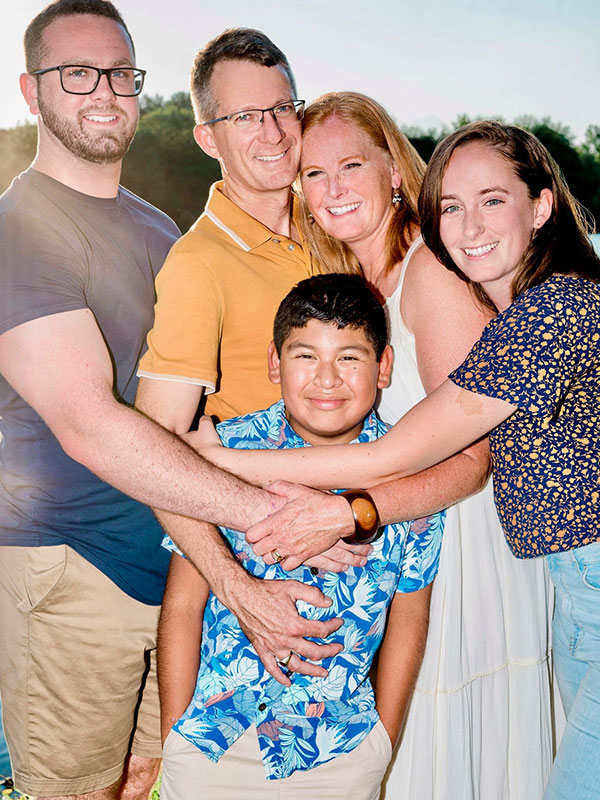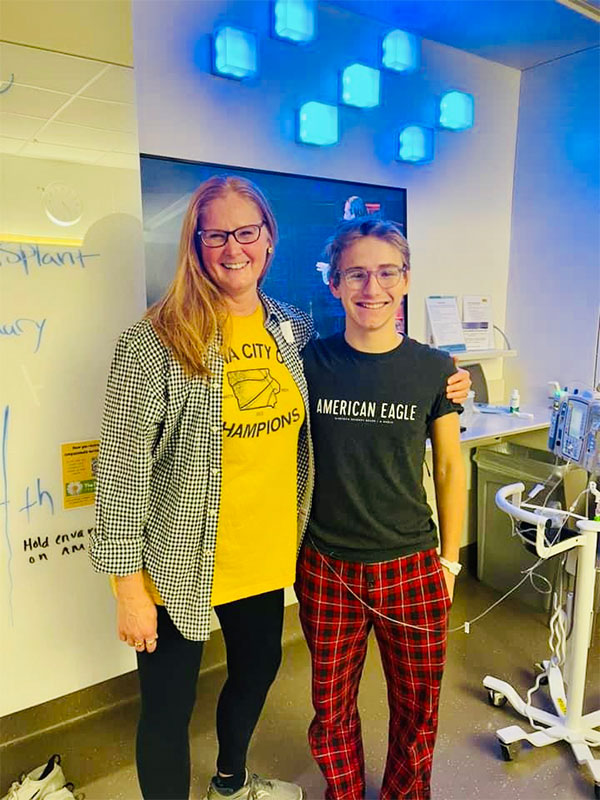A Spare to Share
When Kathi (Klink) Anderson ’92 read the plea of an acquaintance on Facebook to consider living organ donation, she not only considered it—she made the radical decision to donate a kidney for a teenager she barely knew.

Kathi (Klink) Anderson ’92 and Christopher Turnis
A Born Problem-Solver
Kathi is a born problem-solver. It’s how she became a neonatal physical therapist at the University of Iowa Hospitals and Clinics in Iowa City. “I’d get a kiddo who was five and think, Why in the world didn’t they pick up on these problems earlier? And then I’d get a consult on a three-year-old and think, Boy, a year or so earlier and I’m sure I could have had them walking by now. And then I’d get a consult on a one-year-old and think, Oh, they have abnormal movement patterns already—I’m sure we could have prevented this. That’s how I ended up in neonatology, because I wanted to try to prevent as many of the problems as I could early on.”
Another Mom Asking for Help
In addition to working with kids, Kathi and her husband, Mike Anderson ’92, have three of their own, including Mateo, who’s now thriving at 13 but who, because of a large congenital diaphragmatic hernia, spent a lot of time in hospitals early in life.

Kathi (Klink) Anderson ’92 with husband Mike Anderson '92 and children Garth, Samantha, and Mateo
Because of this history, Kathi was familiar with the Turnis family—both the Andersons and the Turnises were featured in a University of Iowa Stead Family Children’s Hospital campaign—and knew that Christopher Turnis’s kidney was damaged from a birth defect. He’d had a transplant at age six, but transplanted kidneys can wear out. In November 2022, Kathi saw a Facebook post from Christopher’s mom, Kristina, explaining that his kidney was failing, that they couldn’t find a match within the family, and if anyone would consider living kidney donation, here’s a link to learn more. Kathi didn’t think twice before clicking. She remembers thinking, “Another mom is asking for help with her medically needy child. I can’t say no to that.”
Getting the Green Light
Of course, the whole thing was theoretical at first. “I went into it completely blind, with no clue that I would ever qualify,” Kathi says. But as she started medical testing and getting green light after green light, the possibility became real.
Along the way, she and Mike, both medical professionals, felt reassured by the thoroughness of the kidney donation program—and the fact that it put donor health first and foremost. “Their emphasis is on protecting the donors,” Kathi says. “They’re not going to let you donate if the outcome doesn’t look extremely good, and the list of reasons to come off of qualifying is long—very long.” The psychological testing is also extensive, with psychologists walking donors through everything from readiness and reasons for donating, to possible financial implications of recovery, to scenarios including meeting (or not) your kidney recipient or dealing with the outcome that a recipient dies.
By May 2023, Kathi had cleared most of the major hurdles for donation—but the decision of whether or not to tell the Turnises that she’d decided to donate was up to her. “It was kind of a God thing,” she laughs. “I always pray: Make it obvious, God, because I’m a little dense and I don’t know what to do.” A chance encounter with Kristina and Christopher at Target in June made up her mind. She sent a long text to Kristina, who got the joyful news on a really hard day.
In mid-October 2023, Kathi got the call: You’re cleared for donation. When can we officially put you on the registry?

Kathi (Klink) Anderson ’92 prepares for surgery at the same time as Christopher Turnis, on whose behalf she donated a kidney.
Making a Match
The National Kidney Registry is a living donation program through which people can donate a kidney on behalf of a loved one or stranger—even if it isn’t a match. The registry then finds a match for that donated kidney and for the loved one or stranger.
Ideally, the matchmaking happens as part of a pair swap, but sometimes the matchmaking happens in wider networks. Kathi’s and Christopher’s surgeries, for example, happened as part of an octet, with four kidneys criss-crossing the country via O’Hare International Airport on the same day in early January 2024.
The deceased donor pool for kidneys is limited, and wait time on that list averages three to 10 years. Living donation can speed up the process to just three months. Kidneys from living donors also last an average of 20–40 years, compared to 10–15 years for kidneys from deceased donors. People who become living donors also ensure that they get moved to the top of the deceased donor list if they or an immediate family member need an organ down the road. Plus, Kathi points out, one in 1,000 people are born with just one kidney anyway so, she says, “You really do have a spare to share!”
Several months after surgery, both Kathi and Christopher are doing well. Kathi was back to work in four weeks and jogging again in six. Christopher plans to study at the University of Iowa and become a child life specialist, helping other families navigate challenging medical situations. “He’s going to be able to help so many kids and so many parents because he’s lived it,” Kathi says.
In May, Kathi was featured on a CBS Mornings segment in which she met the man who received her kidney.
And on the same day in March, Kathi heard from her kidney recipient—a 39-year-old father of three young boys in Southern California—and Christopher heard from his kidney donor—a 25-year-old occupational therapy student in Georgia. “It’s so, so cool how we’re all connected now,” Kathi says.
Kathi urges anyone who’s curious to take the simple step of learning more about living kidney donation. About her decision, she has no regrets, saying, “Life is too short and too hard not to help each other.”
Learn more at kidneyregistry.org.